Midweek Review
CP Chief calls for re-alignment of political forces to thwart Ranil

CP Chairman DEW G says lawmakers here should be aware of what is going on in the world. The Parliament cannot turn a blind eye to global developments, the former MP said, pointing out that the ongoing Ukrainian crisis underscored the need for greater understanding of international affairs as the rapid developments taking place with the US hegemony under threat. The crisis reflects the global power struggle.
By Shamindra Ferdinando
Veteran politician Don Edwin Weerasinghe Gunasekara or DEW G, 88, wants left-wing political parties, including his Communist Party (CP), to join forces with centrist political elements to meet the growing future right wing challenge posed by ‘Pohottuwa,’ backed incumbent President Ranil Wickremesinghe.
The former CP General Secretary warned those opposed to the Wickremesinghe-Rajapaksa juggernaut to reach consensus on a tangible political strategy soon or be prepared to face the consequences.
As things stand, Gunasekara declared that UNP leader Wickremesinghe would be the SLPP’s candidate at the next presidential election, therefore urged, what he called, the genuine Opposition to take a stand.
The CP is represented in Parliament by just one MP Weerasinghe Weerasumana from Matara. The first time entrant to Parliament contested the last general election on the Sri Lanka Podujana Peremauna (SLPP) ticket.
Having parted company with the SLPP, or the Pohottuwa party, the CP is now a constituent of the Uththara Lanka Sabhagaya (ULS).
DEW G acknowledged that left-wing parties, including the CP, couldn’t anticipate any future political alliance with the Rajapaksas’ led party, especially with Basil, an arch right winger, like Ranil, playing such a pivotal role in the family and the party they lead. “Therefore, a realignment of political forces, opposed to the incumbent administration, is a must”, he said.
Gunasekara didn’t mince his words when he admitted that left parties lacked the wherewithal to take on the government, though the ground situation has changed quite drastically, owing to unprecedented public protests, engineered or not by the West, as in the case of the Maidan rebellion in Ukraine in 2014, forced Gotabaya Rajapaksa elected, with 6.9 mn votes, to flee.
A smiling Gunasekara asserted that the emerging world environment could be quite advantageous to Sri Lanka with the US and its fiat currency dollar likely to lose world dominant position, if proper repositioning of political parties and groups takes place here to ensure a Left and Centre combination surging ahead with the best global economic environment after 1945, Gunasekara assured.
In an interview with the writer at the CP’s recently refurbished office at No 91, Dr. N.M. Perera Mawatha, Colombo 08, last week, DEW G discussed a range of issues, both domestic and international, with the focus on the deteriorating economic-political and social crisis against the growing uncertainty caused by restructuring of domestic debt.
Unless left parties reached a consensus with those in the centre, the latter would move to the right to the advantage of Ranil Wickremesinghe, Gunasekera said. “At least 90 percent of the country’s capitalist class is with Wickremesinghe and unless something goes awry, the UNP leader is certain to be SLPP’s nominee with or without machinations by the West.”
The Island
sought the much respected politician’s views on current issues against the backdrop of the CP preparing to celebrate its 80th anniversary this week.
At the onset of the interview, one-time Rehabilitation and Prisons Reforms Minister, an Octogenarian himself, emphasized that what the country experienced was an unprecedented critical situation. “We are at a crossroads. We experienced crises in 1952 and in the ’70s, primarily due to external factors. However, though there were certainly foreign influences and interventions, we created the current catastrophe,” the former lawmaker said.
Gunasekara identified what he called an explosive combination of factors that plunged the country into its worst ever post-independence crisis, namely dearth of foreign exchange even to buy basics, like fuel, drastic drop in government revenue, coupled with a crippling debt due to borrowings at high interest from international bond markets, especially by the previous Yahapalana regime.
Referring to the times of JRJ’s Finance Minister Ronnie de Mel (1977-1988) who presided over Sri Lanka embracing a free market economy in the late ’70s, and his successor M.H.M. Naina Marikkar (1988-1989) at the height of the JVP-led second insurrection (1987-1990), the CP veteran pointed out that the erosion of government revenue began after 1978.
A calamity of unimaginable proportions
Pointing out that in 1978 the government revenue had been 24 percent of the GDP (Gross Domestic Product) a gradual decrease began during JRJ’s reign and by the time Gotabaya Rajapaksa, in his capacity as the President, brought in his brother Basil Rajapaksa as the Minister of Finance, in July 2021, the state revenue had dropped to a poor six percent of the GDP. That the Rajapaksa family compelled Gotabaya Rajapaksa to accommodate BR in the Cabinet, even at the expense of the coalition, is a matter that should be addressed separately, the outspoken politician said. President Gotabaya Rajapaksa paid a very heavy price for exploiting the 20th Amendment to the Constitution to appease the family to bring in Basil Rajapaksa, he added.
The drastic drop of the state revenue to just six percent of the GDP meant that the government didn’t have sufficient funding in Rupees, especially due to a drastic cut in vital taxes, no sooner Gotabaya assumed office. “I have never heard of a disruption of an economy in a particular country for want of whatever local currency, though foreign exchange crisis is certainly not a new occurrence. We ran into trouble at a time when the then government was on a money printing spree.”
Gunasekara attributed the developing crisis to neoliberalist policies adopted in the wake of JRJ’s victory at the 1977 general election. “The change of tax policy in line with neoliberalist strategy brought about the crisis. The gradual change in direct and indirect taxes was nothing but a disaster. At the time of the late Premier Mrs. Sirimavo Bandaranaike, the direct and indirect tax ratio was 70 to 30 percent. JR reduced direct taxes to 55 percent, Ranasinghe Premadasa to 45 percent, Chandrika Bandaranaike Kumaratunga to 35 percent, Mahinda Rajapaksa to 28 percent (during his first tenure as the President), then to 24 percent and subsequently to 18 percent and Basil Rajapaksa brought it down to 14 percent.”
The increasing loss of income, due to a sharp drop in direct taxes, was compensated by corresponding increase in indirect taxes, the former Minister said, added that finally the irect and indirect tax ratio stood at 10 and 90 percent, respectively. Instead of taxing the affluent, those struggling to make ends meet were further burdened, Gunasekara said, alleging that tax evasion at the moment was at its zenith. “There is no point in denying successive governments facilitated the tax fraud. The fraudulent process over the years became part of the system in place,” the ex-MP said.
Asked whether Parliament, as the supreme institution responsible for public finance, should be held responsible for the current predicament, a smiling Gunasekara said that was the position constitutionally.
“However, the actual situation is different or in other words Parliament is irrelevant. The Finance Minister takes decisions on behalf of the Cabinet of Ministers which exercises executive powers in Parliament. Whoever at the helm, exercises political authority thereby implements a strategy that may not be in the best interests of the country though appropriate as a political tool. That is the reality.”
Neoliberalism, or market-oriented reform policies, such as doing away with price controls, freeing of capital markets, and reckless lowering of trade barriers, as well as privatization, brought us to this pathetic situation, the former CP leader said.
Regardless of the recent crash, the Wickremesinghe-Rajapaksa government seemed to be hell-bent on following the same wretched policies. “If not, President Wickremesinghe and his acolytes wouldn’t have considered USD 2.9 bn IMF loan facility as the panacea for our economic ills. In a way we are now in an irreversible situation,” Gunasekara said.
The one-time Chairman of the parliamentary watchdog COPE sarcastically declared without hesitation that he was too optimistic of the much-touted economic recovery plan, based on the much debated agreement with the IMF.
“Don’t forget we sought IMF intervention on 16 occasions previously. And the worst IMF intervention is now underway”, the still crisp thinking octogenarian said.
Parliament has deteriorated to such an extent that it no longer commanded the respect of the public. That, too, contributed to the overall decline, Gunasekara said, explaining how the Ranil-Maithree-led Yahapalana government borrowed heavily from international money markets during the 2015-2019 period, though they have conveniently forgotten their own role in the economic ruin. In foreign money markets, minimum interest was six percent and out of the USD 15 bn taken at such high interest rates as much as USD 12.5 bn was obtained by the Yahapalana rule within a short period of time, Gunasekara pointed out.
Perhaps if Mahinda Rajapaksa won the 2015 presidential election, he, as the Finance Minister, too, would have sought more loans from international money markets, Gunasekara said, asserting that the then Secretary to the Treasury Dr. P.B. Jayasundera may have pushed for early presidential elections as he was aware of the impending financial crisis. “But I tried unsuccessfully to convince President Rajapaksa not to face the electorate as he couldn’t have won under any circumstances,” Gunasekara said.
Bid to save Gotabaya
The former Minister recalled how representatives of political parties met at the residence of lawmaker Tiran Alles in the wake of the violent Mirihana protest, in March 2022, to discuss ways and means of saving Gotabaya Rajapaksa’s mandate. According to him, there had been a general agreement of an interim national government for at least a period of one year until some sort of stability could be restored. Among those who had been present were Dullas Alahapperuma and Maithripala Sirisena and other rebel SLPP MPs, Gunasekara said, adding that consensus couldn’t be reached as the President was not free to act as he desired.
“The President somewhat struggled to address never ending concerns of the Rajapaksa family,” the ex-CP boss said, expressing disbelief that the premiership was first offered to Field Marshal Sarath Fonseka and then SJB leader Sajith Premadasa before beleaguered UNP leader accepted the proposal in the second week of May 2022.
Gunasekara acknowledged the writer’s suggestion perhaps the UNP leader was the best choice, politically, at the time though he personally didn’t agree at all with the destructive market-oriented reform policies agenda pursued by the incumbent President to please the IMF.
In the run-up to the July 2022 calamity, Gunasekara had advised and warned Gotabaya Rajapaksa of the impending economic crisis but was ignored. “Obviously Dr. PBJ and Basil Rajapaksa were at the helm of economic matters. They shaped the damaging policy,” Gunasekara said, recalling him warning Gotabaya Rajapaksa regarding the impending economic crisis at the first public meeting held in Matara following the handing over of nominations for the 2019 presidential election. “The CP organized the Matara meeting where over 5,000 attended. Mahinda Rajapaksa and Mahinda Yapa Abeywardena were among those present. I handed over a printed booklet that dealt with the impending crisis and measures to be taken to Gotabaya. Obviously, he didn’t bother with it.”
Responding to another query, the one-time Prison Reforms Minister said that Gotabaya Rajapaksa was overwhelmed by the Rajapaksa family. “That is the ugly truth. The family didn’t allow the President to proceed on his own path,” Gunasekara said, explaining how the ill-advised Cabinet decision to abolish a range of taxes at the first Cabinet meeting chaired by President Gotabaya Rajapaksa, enactment of the 20th Amendment to pave the way for Basil Rajapaksa’s re-entry into Parliament, chemical fertiliser ban and cancellation of the Japanese-funded Light Rail Project, without consulting the donor, caused immense damage.
The former Minister said that the unveiling of a comprehensive and far reaching alternative economic development programme that dealt with repositioning of Sri Lanka’s foreign trade and economic relations by the CP coincided with their 80th anniversary. Gunasekara emphasized the responsibility on the part of the decision-makers to focus on human resources development, especially against the backdrop of the brain drain and the general perception that there was absolutely no hope of an economic recovery.
Gunasekara said that the vast majority of those who now represented the Parliament, as well as the executive, refused to accept the heavy impact the restructuring of domestic debt was having on the public. Whatever the economic recovery plans under discussion or at the onset of implementation, we lacked the wherewithal and political consensus, Gunasekera said, adding that the issues at hand should be addressed accordingly.
Gunasekara also discussed the continuing failure of Parliament to respond to the growing threats, with quite formidable external interventions taking place right under the noses of the political leadership. References were made to USAID and UNDP interventions at the highest level.
Need for urgent reforms
Gunasekera urged political parties to give sufficient time for new entrants. The ex-lawmaker said that sufficient time should be allocated for new MPs to address Parliament on important issues. How could they deal with a particular issue within three minutes, Gunasekara asked, acknowledging that he wouldn’t have achieved current status if he was denied adequate time.
Gunasekera recalled how he entered Parliament in 1986 in the wake of the death of Sarath Muttetuwegama, 51, lawyer, killed in a car crash at Ratnapura. At the time of his death, Muttetuwegama, married to Manouri, daughter of Dr. Colvin R. de Silva, represented the Kalawana electorate.
Gunasekera said that the decision-making Central Committee of the CP nominated him to fill the vacancy created by Muttetuwegama’s untimely death. There had been provision for a political party to nominate a person to Parliament, within a month, following the creation of a vacancy, and Dew Gunasekera was the CP’s choice though not unanimous. One member of the decision-making body had voted to appoint Manouri Muttetuwegama. In case, a particular political party failed to reach a consensus within a stipulated period of time, the then Election Commission would have called a by-election.
Touching the table, at where he sat, Gunasekara said on the day he took oaths as an MP, the then CP Chairman Pieter Keuneman advised him how to conduct himself in Parliament right here. “We were in this room. I was told to address Parliament while looking at the direction of the Speaker to prevent being disturbed and distracted by opposing MPs. Keuneman stressed the need to be fully prepared to address Parliament. I was also told the importance of having the address in point form and being logical. Perhaps the most important advice was to keep in mind that as an MP he should address the electorate not members of Parliament.”
Towards the end of the interview Gunasekera said that he was not sure whether Gotabaya Rajapaksa wanted to contest the 2019 presidential election or the family fielded him due to Mahinda Rajapaksa being disqualified by the 19th Amendment barring a third term. Gotabaya was not like other Rajapaksas and his wife a humble and gracious lady who never stepped on the toes of anyone. They were never extravagant and basically lived a simple life but Gotabaya Rajapaksa never realized the pitfalls in the political party system here.
Referring to the Matara meeting, immediately after presidential nominations where he advised SLPP candidate Gotabaya Rajapaksa, ex-MP Gunasekera said that the President’s response to concerns raised by the CP at a meeting he chaired on 20 December, 2020, deeply disappointed him.
The meeting had been called to discuss the government response to the Covid-19 threat. “On behalf of the CP, our General Secretary Dr. G. Weerasinghe urged President Rajapaksa not to force Muslims to cremate Covid-19 victims as the decision was not backed by scientific reasons nor by the World Health Organization. The President and others present there were warned of dire consequences of such a drastic decision. But Dr. Weerasinghe’s plea was ignored.”
Gunasekera said that he took advantage of the opportunity to warn the President of the impending economic crisis again. The ex-MP recalled him telling the President that unless he addressed the issue at hand none of those 6.9 mn voted for him would remain when the troubles erupted. “The President didn’t say anything but smiled nicely.”
Gunasekera criticized the Mahanayake Theras’ response to the developing crisis. Underscoring the responsibility on their part to rein in politicians, Gunasekera said that the emergence of the likes of ‘Pastor’ Jerome Fernando and Natasha Edirisuriya should be examined against the backdrop of the pathetic conduct of politicians and most religious leaders.
Commenting on the Aragalaya and related developments, Gunasekera confirmed that the US Ambassador Julie Chung advised Speaker Mahinda Yapa Abeywardena to succeed President Gotabaya Rajapaksa.
He said that National Freedom Front (NFF) leader Wimal Weerawansa’s recent declaration to that effect was based on what he told the MP.
Wickremesinghe’s emergence as the President, an Office he couldn’t have won at an election, highlighted the ruination of the political party system and the dearth of leaders. The UNP, being restricted to just one National List seat, and the SLFP down to one elected MP (other 13 elected on the Pohottuwa ticket) highlighted the collapse of the political party system, as hitherto known, and further deterioration of the situation.
Midweek Review
North: A change in status ahead of Maaveerar Naal
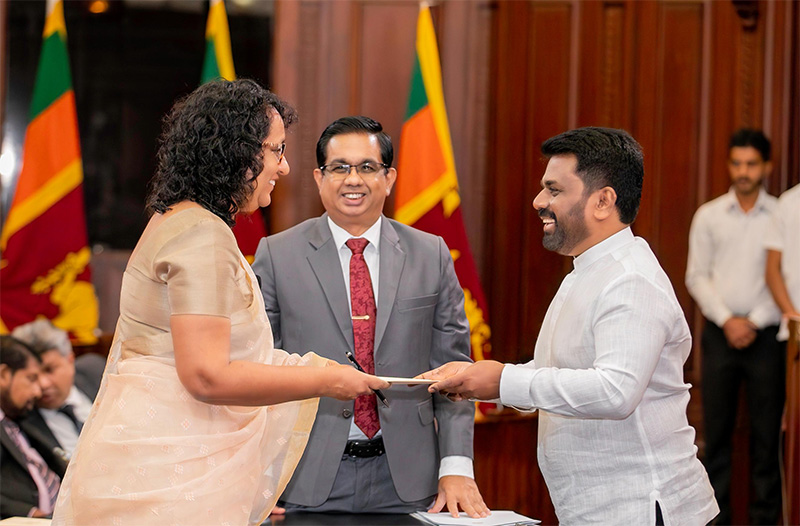
* One-time LTTE mouthpiece TNA is no more
* N & E Tamil speaking representation enhanced
* Fresh look at Sarath Fonseka’s performance at 2010 Prez poll in North required
The new government’s main challenge is ensuring the full implementation of the IMF-led post-Aragalaya economic recovery in line with the Economic Transformation Bill approved by the previous government without a vote. Whatever the side-shows, the focus not only of the government but the Parliament should be on preparing the country to resume debt repayment in 2028 or be ready to face the consequences.
By Shamindra Ferdinando
In a way it was a great thing for the country that the National People’s Power (NPP) scored an emphatic victory at the Nov. 14 general election. Now the Janatha Vimukthi Peramuna (JVP)-led NPPers can have no excuses for not being able to fulfill their promises as would have been the case if the preceding September Presidential election outcome was repeated with the combined Opposition having the lion’s share of the vote, which would have left the country with a virtual hung Parliament of no benefit to anyone other than creating a parliamentary stalemate, leading to fresh political chaos.
We will, however, grant the fact they have a very tall order to fulfill after the previous governments having virtually signed away our sovereignty with the deals they had inked during their tenures.
But we do have a nagging suspicion about someone working in not so mysterious ways against us behind the scene, after what the former US Secretary of State, John Kerry, publicly stated not too long after the defeat of President Mahinda Rajapaksa at the 2015 presidential election when he crowed to the whole world how they had spent several hundred million dollars for regime change operations at the time in several countries, including Sri Lanka. Then we also know since then how a US engineered coup ousted the popularly elected Prime Minister of Pakistan Imran Khan by way of parliamentary and military shenanigans, and then the more publicised way they ousted Prime Minister Sheikh Hasina of Bangladesh and then virtually ruined that country as was the case during the Aragalaya here in 2022 to oust the legally elected President, with a wide mandate, Gotabaya Rajapaksa.
The NPP has accomplished the impossible, even in the North, in the form of securing the Jaffna electoral district at the recently concluded parliamentary election. The NPP obtained three seats, nothing but a historic watershed.
The ruling party also won the Vanni electoral district, the scene of some of the bloodiest fighting during the Eelam War IV (Aug 2006-May 2009). Securing Jaffna and Vanni consisting of Vavuniya, Kilinochchi and Mullaitivu administrative districts, is as difficult as eradicating the conventional fighting capability of the Liberation Tigers of Tamil Eelam (LTTE). The NPP won two seats in the Vanni.
The final phase of the ground offensive was conducted in a corner of the Vanni electorate where LTTE leader Velupillai Prabhakaran met his maker.
The NPP secured two seats in Trincomalee and one in the Batticaloa districts, whereas Digamadulla gave President Anura Kumara Dissanayake’s party four more seats. Altogether 12 out of 29 parliamentary seats available in the five above-mentioned electoral districts ended up with the NPP.
The NPP delivered the stunning blow to those who still pursued separatist agenda, regardless of the LTTE’s demise over 15 years ago. The combined armed forces brought the war to a successful conclusion in May 2009.
The Illankai Tamil Arasu Kadchi (ITAK)-led Tamil National Alliance (TNA) that dominated the Northern and Eastern provinces since 2001 hadn’t been in the fray at the 2024 general election. The TNA that had been in the grip of the LTTE, during 2004-2009, disintegrated 15 years after the end of war, with the ITAK unceremoniously ending the partnership. Ex-TNA members, EPRLF, TELO and PLOTE contested the general election under the ticket of Democratic Tamil National Alliance (DTNA).
The ITAK obtained seven seats (Batticaloa three, Jaffna one, Vanni one, Digamadulla one, Trincomalee one) whereas DTNA won just one (Vanni one). It would be pertinent to mention that ITAK and DTNA fielded a common list for the Trincomalee district to ensure a split in the Tamil vote wouldn’t cost the community much valued representation therein. ITAK Trincomalee leader Kathiravelu Shanmugam Kugathasan, who replaced R. Sampanthan in Parliament at the last Parliament, won that seat.
In addition to the seven elected, the ITAK that contested under the ‘House’ symbol won one National List slot. Ahila Ilankai Tamil Congress (AITC) was the only other party to secure a seat (Jaffna/ Gajendrakumar Ponnambalam) while Independent Group 17 (Jaffna/ Ramanathan Archuna) won one. Altogether Tamil political parties obtained 11 seats, one less than the NPP.
M.A. Sumanthiran (ITAK/Jaffna), Dharmalingham Siddharthan (DTNA/Jaffna) and Sashikala Nadarajah (DTNA/Jaffna), widow of slain ITAK MP Nadarajah Raviraj were some of the big losers. In the east, one-time Chief Minister of the Eastern Province Sivanesathurai Chandrakanthan alias Pilleyan, formerly of the LTTE, failed to retain his Batticaloa district seat. Former LTTE field commander and ex-lawmaker Vinayagamoorthy Muralitharan aka Karuna Amman made an unsuccessful bid to re-enter Parliament also from the Batticaloa district.
In the previous Parliament, there had been 16 MPs representing five Tamil political parties (ITAK, AITC Eelam People’s Democratic Party [EPDP], Tamil Makkal Viduthalai Pulikal [TMVP] and Tamil Makkal Thesiya Kuttani [TMTK]. Last week’s poll eliminated EPDP, TMVP and TMTK while new entrant NPP created political history by winning 11 seats.
In spite of the humiliating setback suffered by those who had been previously in Parliament, the NPP tally has increased the total strength of the Tamil-speaking group representing N & E in Parliament. Perhaps, the successful formation of NPP’s Tamil-speaking wing may influence other political parties to re-examine their overall political strategy. They may not have any other alternative as failure to do so can further weaken their position at the forthcoming Provincial Council and Local Government polls. PC and LG polls are expected to be held next year.
Shanakiyan Rasamanickam, who re-entered Parliament with a convincing win in Batticaloa, consolidated his position, within the party and the district, due to ITAK’s admirable performance there. If not for three Batticaloa seats, ITAK aka Federal Party would have been in an utterly embarrassing position. Batticaloa electoral district is the only one that the NPP couldn’t win. Therefore, the outspoken Rasamanickam can be really happy to have thwarted the NPP in the eastern district.
Now to bury the hatchet between the two or, more correctly, the three literally warring communities here, NPP will have to think out of the box to find a solution that may be by way of sharing power at the centre rather than the periphery, as was successfully done under the Donoughmore Constitution.
Accountability issues
At the presidential election held in Sept. the NPP couldn’t win at least one electorate in the North but did so well several weeks later, it could win Jaffna and Vanni electorates. If not for that sterling performance, the NPP couldn’t have secured an unprecedented 2/3 majority. President AKD should be ever grateful to the northern and eastern electorates for facilitating a 2/3 majority.
Since the introduction of the proportional representation at the 1989 Parliamentary election, no party succeeded in securing a 2/3 though many alleged the Rajapaksas abused such huge mandates. They were, of course, referring to the UPFA securing 144 seats and 145 seats at the 2010 and 2020 general elections, respectively. For a simple majority, the winning party needs 113 seats while 2/3 means 150 seats.
Against the backdrop of NPP’s victory in the N & E, the new Parliament should review Sri Lanka’s response to post-war accountability issues. Since the eradication of the LTTE, the TNA propagated politically motivated unsubstantiated war crimes allegations, both here and abroad. Finally, the treacherous Yahapalana government (2015-2019) betrayed the war-winning armed forces at the Geneva-based United Nations Human Rights Council (UNHRC) in Oct 2015. The accountability resolution that had been co-sponsored by the US-led grouping and Sri Lanka was meant to pave the way for a new Constitution aimed at doing away with the country’s unitary status.
Interestingly, the war-winning Army Commander, Sarath Fonseka, who had been promoted to the rank of Field Marshal, in March 2015, served in that Yahapalana Cabinet, chaired by President Maithripala Sirisena. The role played by the then Premier Ranil Wickremesinghe and the late Foreign Minister Mangala Samaraweera in that despicable act is in the public domain. The failure on the part of Fonseka, who served President Sirisena’s Cabinet to vigorously oppose the government move is still a mystery.
The writer repeatedly discussed the failure on the part of Parliament and urged concerned political parties to raise the Yahapalana-TNA Geneva operation after the same lot fielded Fonseka as the common presidential candidate in 2010. Although Fonseka lost the contest by a massive 1.8 mn votes to war-winning President Mahinda Rajapaksa, he handsomely won the Jaffna, Vanni, Trincomalee, Batticaloa and Digamadulla electoral districts at the same election.
The NPP’s excellent showing in the N & E at the recently concluded general election should be examined taking Fonseka winning the former war zones 14 years ago.
Having alleged Fonseka’s Army of war crimes throughout the northern campaign, the TNA had no qualms in backing the Sinha Regiment veteran. Unfortunately, political parties represented in Parliament never bothered to raise TNA’s duplicity. Instead, all of them shamelessly and brazenly played politics with the issue, seeking petty political advantage at the expense of the armed forces. There hadn’t been a single instance of a war-winning country betraying its armed forces hitherto anywhere in the world. It was only the Maithripala Sirisena/Ranil Wickremesinghe govt. that achieved that dastardly act.
The JVP, though being not part of the Yahapalana Cabinet, never opposed the government’s move against the armed forces. However, the NPP’s victory in the North, perhaps would give an opportunity for President AKD, who is also the Defence Minister and Commander-in-Chief of the armed forces, to address the issue at hand afresh. President AKD retained the Defence portfolio when the new Cabinet of Ministers was sworn in last Monday.
The developing situation in the North may help post-war national reconciliation efforts. Successive governments deliberately allowed further deterioration of relations between the two communities by not taking apt remedial measures. Those who propagated lies were allowed to do so much to the disappointment of the armed forces. Parliament turned a blind eye even when the US and Australia et al denied visas to retired and serving officers and US imposed travel ban on the then Army Commander Gen. Shavendra Silva, the incumbent Chief of Defence Staff (CDS). Maj. General Chagie Gallage, now retired, is another victim of external reprisals.
Maaveerar Naal (Great Heroes’ day)
The Tamil Diaspora must have been quite surprised by the outcome of the general election. Some interested parties played down the importance of NPP victory in the North on the basis of low turnout of voters. It would be interesting to observe how the Diaspora and political parties here mark this year’s Maaveerar Naal. Commencing 1991, the LTTE used to celebrate Nov. 21-27 week as Great Heroes Week. During the period the group wielded power, the weeklong celebrations and activities received even international media attention.
This year, Maaveerar week is scheduled to commence on Nov 21 (tomorrow), the day the 10th Parliament meets. What would those elected from the NPP, ITAK and other parties do this year? Would interested parties seek to cause some unnecessary commotion in a bid to embarrass the government. Let us hope the government would handle the situation cautiously as opportunistic elements on both sides seek to exploit the developments. ITAK’s Sivagnanam Shritharan paid tribute to fallen Maaveerar at Kanagapuram, Kilinochchi.
The NPP’s unexpected victory in the north may compel not only Tamil Diaspora but Western countries, particularly Canada, to review their position.
Canada declared May 18 as Tamil Genocide Remembrance Day as Premier Justin Trudeau’s government sought to appease Canadian voters of Sri Lankan origin. Canada cannot under any circumstances ignore the Tamil vote received by the NPP as people discarded unsubstantiated war crimes allegations directed at the government, for the second time. Had the northern electorate believed the Army wantonly killed civilians on the Vanni east front in 2009, as alleged by the UN, they wouldn’t have voted for Fonseka. Perhaps, the people wanted the government to bring the war to an end at any cost. Having waged two terror campaigns in 1971 and 1987-1990, the JVP should be able to comprehend the need and the responsibility on the part of the government of the day to take whatever measures necessary to deal with the challenge.
The NPP was formed in 2019 just months ahead of the presidential election as the JVP realized it couldn’t push ahead on its own but needed wider public support. The NPP achieved that with ease within six years.
In August 2006, the then President Mahinda Rajapaksa went ahead with an-all-out campaign against the LTTE after failing to convince them to negotiate for a final settlement. President Rajapaksa had no option but to go on the offensive after the failed LTTE assassination attempts on the then Army Commander Lt. Gen. Fonseka (April 2006) and then Defence Secretary Gotabaya Rajapaksa (Oct. 2006). The TNA remained committed to the LTTE’s murderous cause until the very end.
A matter for serious concern
An unbelievably large number of voters skipped the general election. All political parties, including the NPP, should be concerned over the unprecedented deterioration of voter interest, especially after a thrilling presidential election brought AKD to power just six weeks ago. A substantial increase for the NPP from 5,634,915 votes (42.31 %) at the presidential to 6,863,186 (61.56%) at the general election just weeks later shouldn’t be allowed to divert attention to the massive drop in public interest. Well over half a million rejected votes, too, must worry all.
The NPP won 159 seats, including 18 National List slots, nine more than required for a 2/3 majority. At the presidential election 3,520,438 voters refrained from exercising their franchise. But that figure increased to 5,325,108 at the general election while the number of rejected votes, too, recorded a significant increase. According to the Election Commission, at the presidential poll, the number of rejected votes was 300,300 while the general election recorded 667,240 rejected votes.
What really caused such an increase in the number of rejected votes was when the number of polled votes dropped from 13,619,916 votes (79.46%) to 11,815,246 (68.93%)? In other words of the 17,140,354 people eligible to vote, a staggering percentage decided not to. Voter apathy is not healthy. Not healthy at all.
A rethinking on the part of the SJB and New Democratic Front (NDF/consisted of former SLPP lawmakers and UNP) is necessary as they couldn’t at least retain the number of votes received at the presidential election. SJB that polled 4,363,035 votes (32.76 %) at the presidential poll could muster only 1,968,716 (17.66%) at the general election, while NDF could secure 500,835 (4.49%) having polled 2,299,767 (17.27%) just weeks ago. The SJB and NDF ended up with 40 seats (including five NL slots) and five seats (including 2two NL slots) while the SLPP that won 145 seats at the 2020 general election had to be satisfied with three seats, including one NL slot.
Both Sajith Premadasa and Ranil Wickremesinghe should seek remedial measures before the EC announced PC and LG polls. Perhaps, divided groups have to unite under one banner either under SJB or UNP or face annihilation at the PC and LG polls. For Premadasa and Wickremesinghe time seemed to have run out.
The SLPP obtained 350,429 votes (3.14%) at the general election up from 342,781 (2.57 %) at the presidential election. For the SLPP a rapid recovery process will never be possible as its only NL member and leader of the minute group Namal Rajapaksa is likely to be the target of corruption investigations. The SLPP group consists of Namal Rajapaksa, newcomer Chanaka Sampath (Galle) and D.V. Chanaka (Hambantota).
Fifteen political parties represented the last Parliament. They were SLPP (145), SJB (54), ITAK (10), NPP (03), EPDP (02), AITC (02), TMVP (01), SLFP (01), MNA (01), TMTK (01) TMTK, ACMC (01), NC (01), SLMC (01), UNP (01) and OPPP (01). The new Parliament will be represented by 13 political parties and one independent group – namely NPP 159, SJB 40, ITAK 08, NDF 05, SLPP 03, SLMC 03, Sarvajana Balaya (NL), UNP (01), DTNA (01), ACTC (01), ACMC (01), Jaffna Ind. Group 157 (01) and SLLP (01).
Midweek Review
‘Ramayanizing’ Sri Lanka by Courtesy of SriLankan Airlines

 (The author is on X as @sasmester)
(The author is on X as @sasmester)
SriLankan Airlines’ five-minute commercial promoting the so-called ‘Ramayana Trail’ in Sri Lanka is being accepted very naively as an enticing and heartwarming advertisement by Sri Lankan and Indian viewers across social media. Predictably, the video has also gone viral. It shows a young child being educated about aspects of the Ramayana legend by his grandmother, while zooming in on locations in Sri Lanka where local mythology has made associations with some narratives of the Ramayana. Beyond the rave reviews of the commercial in Sri Lanka and India, an astute observer would in fact see it as a very problematic rendition for one simple reason. That is, when viewed from the perspective that it is paid for by SriLankan Airlines, a government entity funded by local taxpayers, what is said and promoted, in effect, would be through the voice of the state and the government. Therefore, for instance, when the granny tells the child, “all the places in Ramayana are real. Today, we know Lanka as Sri Lanka”, in one careless and ill-thought-out fell swoop, SriLankan Airlines has given credence to belief as evidence, myth as history, fiction as fact, asserting Ramayana’s Lanka as present-day Sri Lanka when numerous Indian renditions of the story locate parts of Ravana’s Lanka well within contemporary India.
Admittedly, the commercial will certainly attract Indian tourists and pilgrims, particularly from the northern parts of the country. The question that comes to mind however is whether this is the only way to promote the trail? Many of my friends have already made the trip without the nudging of the new advert. The advert also begs the question, whether local sensitivities and cultural meanings linked to the Sanskrit epic were ever considered when it was conceptualised, or at any point even after in the process. More importantly, who gave the final seal of approval?
The hegemonic narrative in the commercial is what one might call a ‘North Indian Brahminic’ approach to the Ramayana, which erases other versions of the epic including the Ravana-centric myths in Sri Lanka itself. Unfortunately, it is this hegemonic narrative that has been making the rounds for some time in India with Rama as its protagonist and Ravana as the absolute villain, the all-evil-encompassing antagonist. In this rendition, it is no longer simply an ancient epic or a story of innocence and faith, but a contemporary political narrative with considerable cultural power, authority and reach, performed and used by the state itself. This narrative feeds directly and indirectly into the somewhat imperialist designs of certain contemporary Indian political forces so aptly encapsulated in the hegemonic political concept of Akhand Bharat. However, in real life, understandings of the Ramayana have never been this simple or linear.
The title of Prof A.K. Ramanujan’s seminal essay, ‘Three Hundred Ramayanas: Five Examples and Three Thoughts on Translation’ offers a clear indication into the many versions of the Ramayana and the complex narrative traditions of both India and lands beyond where aspects of the epic have become part of local myths, folktales or performance traditions. Interestingly, Prof Ramanujan’s essay was dropped from the Bachelor of Arts in History (Honours) degree programme at Delhi University in 2011 amidst considerable agitations lead by Akhil Bharatiya Vidyarthi Parishad, a right-wing students’ organization, precisely because its contents complicate the way in which the political narrative that is the Ramayana today is presented.
It is truly unfortunate that the narrative given prominence in the Sri Lankan Airlines advert stems from this dominant, parochialized and utterly politicized version of the Ramayana which sweepingly demonizes Ravana. This broad-brush demonization reaches its peak in India during Dussehra, the festival during which effigies of Ravana are burnt to symbolize the vanquishing of evil (Ravana) by good (Rama). However, interestingly, in many of India’s tribal areas, the narrative is closer to that in Sri Lanka, where Ravana is seen as a hero, and importantly as a source of knowledge and ethics. In 2017, in the Katol area in the State of Maharashtra, tribal people forced the local administration to stop the burning of Ravana effigies during Dussehra. In Nashik, also in Maharashtra, tribal folklore suggests that the area was part of Ravana’s kingdom and was governed by his sister Surpanakha along with her husband. This understanding of Ravana’s kingdom is nowhere near Sri Lanka as promoted by SriLankan Airlines. In some tribal Gond villages in Maharashtra, Ravana is worshiped as a god, clearly evident during Dussehra. He is also worshiped in many other locations including, Mandsaur and Ravangram in Madhya Pradesh; Bisrakh in Uttar Pradesh; Kangra in Himachal Pradesh; Mandya and Kolar in Karnataka, and Jodhpur in Rajasthan. Similar practices are seen in the tribal areas of Chhattisgarh, Jharkhand and West Bengal as well.
In Tamil Nadu in India’s south, there are many people who align themselves with ‘Dravidian’ ideologies, promoting Ravana as a politico-cultural icon. One source of motivation for this stems from the manner in which Ravana is eulogised for his valour in Kambaramayanam – the Tamil version of the Ramayana – even though here, too, the main premise of the hegemonic account is maintained. The more obvious source for this reverence is Ravana Kaaviyam written by Pulavar Kuzhandhai and published in 1946. It is a 20th century attempt to deconstruct the Ramayana based on the argument that the mainstream Ramayana was an attempt to establish the supremacy of the ‘Aryan race’ who lived in northern India, over the ‘Dravidians’ in the south. Here, Ravana is seen as a ‘Dravidian’ king, and in essence very similar to the Sinhala renditions of Ravana. In both these popular Sinhala and Tamil versions, he is presented as a noble king, epitomising justice, courage and compassion, and also a wise person and scholar. While categories such as ‘Dravidian’ and ‘Aryan’ as ethno-cultural references as opposed to linguistic references are not part of my academic vocabulary, the attempted deconstruction is nevertheless interesting as it also offers a glimpse into the manner in which 20th and 21st century hegemonic North Indian politics are understood by some sections in the country’s south.
What is evident is that a counterculture movement is currently mobilising tribal and Dalit communities in several Indian states such as the above to vindicate Ravana and ‘rescue’ him from the negative light in which he has been portrayed in the current dominant version of the Ramayana, the one SriLankan Airlines has blindly based their commercial on. Due to this blindness, these interesting and telling complexities and intriguing political and cultural references have no resonance whatsoever in the SriLankan Airlines advert.
I come again to the question posed at the beginning of this essay: is this the only way to do such a promotion funded by the Sri Lankan government? Cannot the state-funded national carrier attract Indian tourists and pilgrims by presenting the places the local tourism industry and Indian tour and pilgrimage operators want these travellers to visit by offering the local interpretation? After all, Sri Lanka does not have a performance tradition of the Ramayana and hardly any concrete memories of the epic and its numerous episodes as a specific text. Instead, fragments of these exist scattered on the landscape throughout the island as places where specific incidents related to the Ramayana had supposedly happened. These manifest through several local folk tales and myths where Ravana is ever present as a local hero and Rama is virtually absent except when contextually required. Moreover, some of these places refer to many other stories too, which have been historically more prominent locally than the Ramayana-related narratives. However, right now, the Ramayana ‘stories’ are given considerable local and national prominence as a rational economic decision taken by people in these areas in the interest of tourism which translates into simple commercial gain. This is understandable.
The question is, what prevented SriLankan Airlines from beginning its advert with the famed flying machine of Ravana known in Sinhala as dandu monaraya (and in India as Pushpaka Viman), often referred to in influential local interpretations as the first of its kind, and predating the Wright Brothers’ invention? Is it a lamentable lack of imagination and creativity, or sheer ignorance? After all, the logo of Air Lanka, the predecessor to SriLankan Airlines, found its genesis in this story, which continues to date in a different form. This way, potential tourists could have been shown the same locations referred to in the current advert, but viewed from the sky, as if one were flying in the dandu monaraya like Ravana may have done in mythical times. This would also be very similar to the way ancient Sri Lankan poets of the sandesha tradition described local landscapes and built environments from the point of view of a bird in flight taking a message to a king, a Buddhist monk or some other such personality. Salalihini Sandeshaya and Hansa Sandeshaya written in the 15th century during the Kotte Period come to mind.
In this manner, the core places in the ‘Ramayana Trail’ could have been flagged for tourist and pilgrim interest while maintaining a distinct sense of local culture and identity that SriLankan Airlines should ideally be marketing. This is not to make Indian tourists and pilgrims cast aside their own beliefs, narratives and interpretations when visiting Sri Lanka. That is their right and not in any doubt. The crux of the matter is, why would SriLankan Airlines be so north Indian and Brahminic, and willingly succumb to the dominant and exclusivist version of the Ramayana promoted by the Indian state and many ordinary people to the exclusion of all other narratives in India itself? By doing so, SriLankan Airlines is taking itself, the government, the state and by extension all of us Sri Lankans, right into the bosom of the Indian state’s cultural and political colonialism typified by the concept of ‘Akhand Bharat’ as noted earlier. If picked up by opposition forces in the politically polarised Sri Lankan society, the advertisement can become a political statement, which has the potential to create needless rifts within Sri Lanka itself.
But then again, one cannot expect these complexities to be understood by the decision makers at SriLankan Airlines who obviously are far removed from the local cultural terrain as well as existing cultural hegemonism emanating from across the Palk Strait. The national carrier, in its haste to soar, as well as absence of foresight and lack of enlightenment of local culture has imprisoned Sri Lanka in a hegemonic North Indian politico-cultural narrative. This is also a sign of lacking national pride despite constant and oftentimes annoying rhetoric. One can only hope, the Sri Lankan government will revisit how this was done in the first place and ensure this kind of culturally crude reductionism of our own traditions and folklore does not take place in the future in state-sponsored activities carried out with public funds.
I cannot but be reminded of a quote by Voltaire when reflecting on the manner in which politics of this kind flow, emerge, and reemerge in Sri Lanka while nothing is ever learned: “It is difficult to free fools from the chains they revere.”
Midweek Review
Lone Voice of Reason
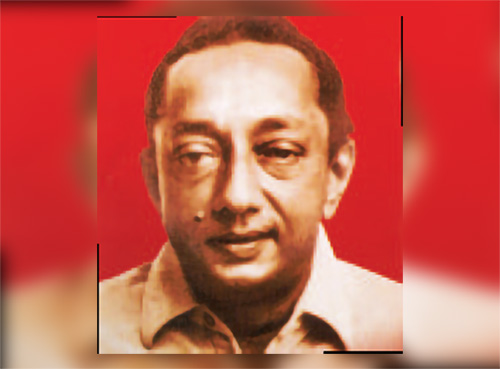
By Lynn Ockersz
There’s this ‘narrative’,
In the ‘Isle of Smug Smiles’,
That the time’s ripe,
To craft the epitaph,
Of the political opposition,
Now that the restive House,
By the idyllic waterway,
Is in the grip of a single party,
In all too familiar history,
But there’s a glowing example,
From the distant eighties,
When Sarath Muththetuwegama,
Lone Member of the CPSL,
Won the admiration of the country,
Through his inspiring speeches,
Clinching the timeless point,
That Quality is superior to Quantity.
-
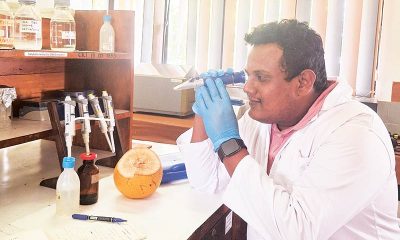
 Life style6 days ago
Life style6 days agoKing of coconuts heads for a golden future
-
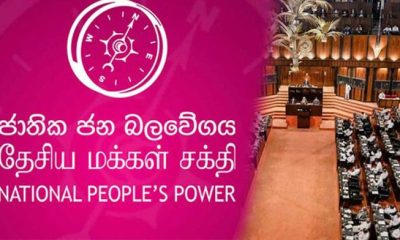
 News5 days ago
News5 days agoNPP appoints two defeated candidates as NL MPs
-
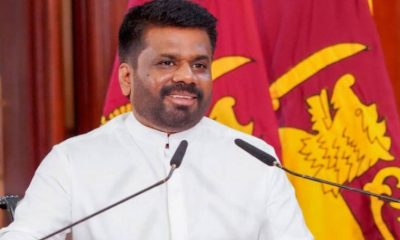
 News7 days ago
News7 days agoPresident warns his party: “We will fail if we view power as an entitlement to do as we please”
-
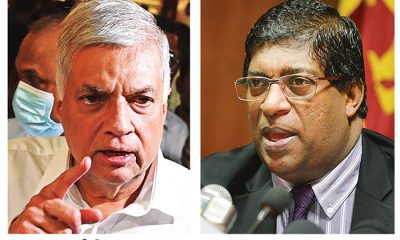
 News4 days ago
News4 days ago‘Gas Cylinder’ explodes; Ranil flays NDF Secy. for submitting Ravi’s name
-

 Midweek Review3 days ago
Midweek Review3 days ago‘Ramayanizing’ Sri Lanka by Courtesy of SriLankan Airlines
-
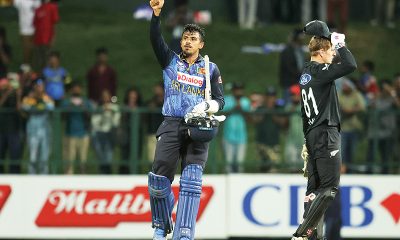
 Sports4 days ago
Sports4 days agoMaking batting compulsory for bowlers has worked – Theekshana
-

 Editorial7 days ago
Editorial7 days ago‘Maroon Wave’ and AKD Magic
-

 Editorial6 days ago
Editorial6 days ago‘Twas a great victory













